Test Bank for Microbiology 1st Edition by Wessner
$25.00
Complete downloadable Test Bank for Microbiology 1st Edition by Wessner. INSTRUCTOR RESOURCE INFORMATION
TITLE: Microbiology
RESOURCE:Test Bank
EDITION: 1st Edition
AUTHOR: Wessner, Dupont, Charles
PUBLISHER: John Wiley and Sons
Download sample
Description
Complete downloadable Test Bank for Microbiology 1st Edition by Wessner. INSTRUCTOR RESOURCE INFORMATION
TITLE: Microbiology
RESOURCE:Test Bank
EDITION: 1st Edition
AUTHOR: Wessner, Dupont, Charles
PUBLISHER: John Wiley and Sons
Table of content
1 The Microbial World
2 Bacteria
3 Eukaryal Microbes
4 Archaea
5 Viruses
6 Cultivating Microorganisms
7 DNA Replication and Gene Expression
8 Viral Replication Strategies
9 Bacterial Genetic Analysis
11 Regulation of Gene Expression
12 Microbial Biotechnology
13 Metabolism
14 Biogeochemical Cycles
15 Microbial Ecosystems
16 The Microbiology of Food and Water
17 Microbial Symbionts
18 Introduction to Infectious Diseases
19 Innate Host Defenses Against Microbial Invasion
20 Adaptive Immunity
21 Strategies and Consequences
22 Viral Pathogenesis
23 Eukaryal Microbe Pathogenesis
24 Control of Infectious Diseases
[embeddoc url=’https://etestbanks.net/pdf_samples/Test_Bank_for_Microbiology_1st_Edition_by_Wessner_sample_chapter.pdf’]







